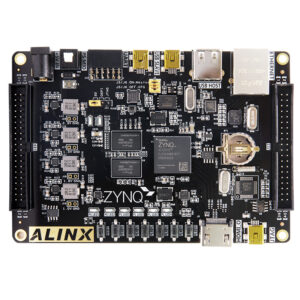By SalaiDeva Thirumani
Why Op-amp?
Op-amp is used to amplify the weak signal. In comparison to a Multi-transistor (2) implementation of an amplifier circuit op-amps are a single chip solution. E.g. Darlington Pairs which consists of two transistors can be replaced with a single Op-amp IC.
Definition:
An operational amplifier (op-amp) is a DC-coupled high-gain electronic voltage amplifier with a differential input and, usually, a single-ended output.
Typical Op-amp Circuit:
| V+ | Non-inverting input |
| V- | Inverting input |
| Vout | Output |
| Vs+ | Positive Power supply |
| Vs- | Negative Power supply |
Op-amp Parameters:
Open Loop Gain:
Infinite – The main function of an operational amplifier is to amplify the input signal and the more open loop gain it has the better performance. Open-loop gain is the gain of the op-amp without positive or negative feedback and for an ideal amplifier the gain will be infinite but typical real values range from about 20,000 to 200,000.
Input Impedance:
Infinite – Input impedance is the ratio of input voltage to input current and is assumed to be infinite to prevent any current flowing from the source supply into the amplifiers input circuitry ( Iin = 0 ). Real op-amps have input leakage currents from a few pico-amps to a few milli-amps.
Output Impedance:
Zero – The output impedance of the ideal operational amplifier is assumed to be zero acting as a perfect internal voltage source with no internal resistance so that it can supply as much current as possible.
Offset Voltage:
Zero – The amplifiers output will be zero when the voltage difference between the inverting and the non-inverting inputs is zero, the same or when both inputs are grounded. Real op-amps have some amount of output offset voltage.
The Op-amp should be selected based on the gain; Voltage Gain (AV) is the ratio between the output voltages to the input voltage.
In terms of Decibel,
Input Signal Modes:
There are three types of Input signal modes
- Single ended Mode
- Differential ended Mode
- Common mode
Single ended Mode:
In the single ended mode whether the input signal is applied to either inverting or non-inverting terminal of the Op-amp.
In the single Ended Input two main categories are there
- Inverting amplifier-If the signal is fed into the V- is said to be Inverting amplifier.
- Non-Inverting amplifier -If the signal is fed into the V+ is said to be Non- Inverting amplifier.
Differential ended Mode:
Two out of phase signal is applied to the inverting and non-inverting input. Differential ended mode is applied where we need differential output between the two inputs eg. Comparator.
Common Mode:
Same phase of signal is applied to the inverting input and non-inverting input. In the common mode signal if equal input signals are applied it cancels each other, particularly useful in dejection of the unwanted signal such as noise this property is termed as CMRR (Common Mode Rejection Ratio). It provides Zero gain.
Op-amp Circuits:
- For negative feedback, were the fed-back voltage is in “anti-phase” to the input the overall gain of the amplifier is reduced.
- For positive feedback, were the fed-back voltage is in “Phase” with the input the overall gain of the amplifier is increased.
- By connecting the output directly back to the negative input terminal, 100% feedback is achieved resulting in a Voltage Follower (buffer) circuit with a constant gain of 1 (Unity).
- Changing the fixed feedback resistor ( Rƒ ) for a Potentiometer, the circuit will have Adjustable Gain.
- By adding more input resistors to either the inverting or non-inverting inputs Voltage Adders or summers can be made.
- Voltage follower op-amps can be added to the inputs of Differential amplifiers to produce high impedance Instrumentation amplifiers.
- The Differential Amplifier produces an output that is proportional to the difference between the 2 input voltages.
- The Integrator Amplifier produces an output that is the mathematical operation of integration.
- The Differentiator Amplifier produces an output that is the mathematical operation of differentiation.
- Both the Integrator and Differentiator Amplifiers have a resistor and capacitor connected across the Op-amp and are affected by its RC time constant.
- In their basic form, Differentiator Amplifiers suffer from instability and noise but additional components can be added to reduce the overall closed-loop gain.
For a good Op-amp it should possess
- Short circuit protection: To protect circuit when outputs are shorted.
- No latch Up: To prevent op-amp from being hanging in one state.
- Input offset Nulling: It’s obtained by using Potentiometer precisely by keeping output voltage at zero v for 0v input.
For more information please visit: www.tenettech.com
For technical query please send an e-mail: info@tenettech.com















